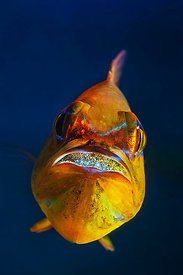1/2 right. As i initially thought, males do as well.
There are PATERNAL & MATERNAL mouthbreeders.
"Mouthbrooders protect their young by using their mouths as shelter.
Photo courtesy of Réunion Underwater Photography | www.rup.reNumerous breeds of fish are considered to be mouthbrooders; some are paternal mouthbrooders (meaning that the male offers shelter) and others are maternal mouthbrooders. Species of fish defined as mouthbrooders include cichlids, sea catfish, cardinalfish, Bagrid catfish, pikeheads, jawfishes, gouramis and arowanas."
Paternal mouthbrooders are species where the male looks after the eggs. Paternal mouthbrooders include the arowana, the mouthbrooding betta Betta pugnax, and sea catfish such as Ariopsis felis. Among cichlids, paternal mouthbrooding is relatively rare, but is found among some of the tilapiines, most notably the black-chin tilapia Sarotherodon melanotheron.
In the case of the maternal mouthbrooders, the female takes the eggs. Maternal mouthbrooders are found among both African and South American cichlids. African examples are the haplochromines, such as the mbuna, Astatotilapia burtoni, and the dwarf mouthbrooders Pseudocrenilabrus multicolor, and some of the tilapiines, such as Oreochromis mossambicus and Oreochromis niloticus. The South American maternal mouthbrooders are all members of the subfamily Geophaginae (commonly known as "eartheaters" on account of their substrate-sifting feeding mode) such as Gymnogeophagus balzanii and Geophagus steindachneri.
Biparental mouthbrooding occurs where both parents take some of the eggs. This is relatively rare, but is found among the cichlid genus Xenotilapia, and a single catfish, the spatula-barbled catfish (Phyllonemus typus).
Typically, after courtship, the male fertilises the eggs and then collects them in his mouth, holding onto them until they hatch. During this time he cannot feed. Among the maternal mouthbrooding cichlids, it is quite common (e.g., among the mbuna) for the male to fertilise the eggs only once they are in the female's mouth. Some cichlids are able to feed while mouthbrooding the eggs, but invariably they feed less often than they would otherwise do, and after mouthbrooding one batch of eggs, all mouthbrooding fish are underweight and require a period of time to feed and make up for the depletion of their energy reserves.[2]
In all cases, the eggs are protected until they hatch and the fry become free swimming. Only in some cases does the parent extend protection to mobile juveniles. Among the cichlids and arowanas, extension of brood care to the fry is common, and they have behavioural cues to tell fry swimming and feeding away from the parent that danger is approaching and that they should return to their parent's mouth. By caring for their offspring in this way, mouthbrooding fish are able to produce smaller numbers of offspring with a higher chance of survival than species that offer no broodcare.
- Forums
- DJPIN
- Wednesday July 18 2018
1/2 right. As i initially thought, males do as well. There are...
- There are more pages in this discussion • 4 more messages in this thread...
You’re viewing a single post only. To view the entire thread just sign in or Join Now (FREE)





